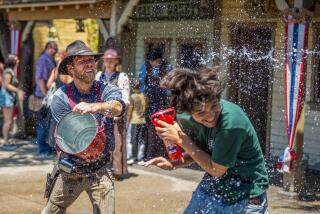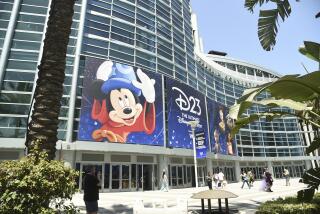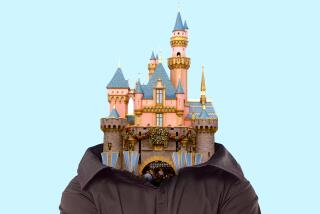Theme Parks: Customers Get Crowded Out
- Share via
Some say the best time to visit big theme parks is Christmas, others say Super Bowl Sunday. Some say don’t go in the summer, others say don’t go in the afternoons.
I say, don’t go.
I say this as one who has gone every year, religiously, to most of the theme parks in Southern California, theme park capital of the world. Like everyone else, I go willingly, pressured by children, drawn by the assumption of “amusement” in amusement parks.
But more and more, these places seem crowded and repetitive, their employees, like their visitors, dulled by endless lines, virtually lip-syncing their assigned spiels. It’s a tiring visit, its main feature the agonizingly long waits for very short entertainments, many offering only empty calories, devoid of intellectual content or information.
Certainly no one with a choice should go in the summer, when parks such as Disneyland double their attendance. The parks themselves want summer left to tourists; constant promotions the rest of the year encourage locals to visit off-season.
For those who must go in summer, park officials suggest going early and rushing immediately to favorite areas. Universal Studios makes it easiest by opening at 7:30 a.m., but there and elsewhere, any time before 10:30 beats the late morning surge. Apparently, it takes the cooperation of the gods to move the American family out any earlier.
They also suggest staying late because crowds thin out in the evening. Some (Disneyland, for one) offer special evening-only rates. But be warned: If they’ve booked some blockbuster entertainment or offered a one-time promotion to some company the size of a state government, the park could be cold, dark and crowded.
Finally, they advise concentrating on attractions that don’t interest most people. But these aren’t likely to interest the people getting that advice either.
Management’s best solution to a frustrating visit is multiple visits, made on a season (one-year) pass. Some are forbidding. Disneyland’s adult pass is $180--a saving over single admissions ($27.50) only after seven visits. The average buyer of Knott’s Berry Farm’s $99.95 pass ($21.95 single admission) visits 10 to 12 times a year. Savings aside, it’s my personal idea of hell.
Some are more reasonable--Universal’s $49.50 adult pass ($24.50 one-time admission), Magic Mountain’s $49.95 ($24 one-time), Sea World’s $45 ($22.95 one-time). Universal’s pass confers an extra advantage: Pass holders go to the head of the main tram line, whenever they arrive.
Universal is on to something. People are not buying season tickets to a park because this is their local mall. They’re not satisfying a yen for all that bas cuisine, its apogee the Polynesian-style dinner. They’re not hot to shop for plastic wallets and logo T-shirts, or even that Disneyland specialty, ears.
They’re buying season passes because in one terrible 10-hour day, with kids, they could only manage five rides, two snacks, a fast-food lunch and tram rides to and from the parking lot. They have to go back.
These parks are simply too crowded now for a pleasant visit, never mind just a visit in which one sees the whole park. Unless one visits in the middle of the night--and sometimes even then--the day is spent waiting 50 minutes and more for rides that last less than five. This is not fun.
Nor is there anything fun about the famous “crowd control”--the tight parallel rope lines that loop people this way, then that, a dozen times before they reach a ride. This is a tedium that cannot be relieved by occasional strolling minstrels or TV monitors showing cartoons, park scenes and soft-drink ads.
Maybe these parks need some kind of reservation system, as at blockbuster museum shows, assigning visitors a period of hours to move, less impeded, from one area to another. Maybe it’s an overall attendance limit. Maybe they need to re-engineer some rides, many of which were built for yesteryear’s crowds.
These are, after all, inventors and engineers. They’ve come up with talking Lincoln figures, with instant rapids, avalanches and earthquakes, with rides that turn riders upside-down and inside-out. Surely they can come up with more innovative ways to move crowds.
Multiple visits aren’t the answer. Such repetition requires more substance, more real interest value. Ride buffs are drawn to Magic Mountain’s collection of roller coasters (still bemoaning the hour waits). Knott’s Ghost Town buildings are little museums of artifacts, rarely mentioned, even by Knott’s management. Universal and Sea World have real information--on the making of movies, the lives of marine creatures--though it’s sometimes smothered by the emphasis on amusement.
But much of theme park fare is passive entertainment, like television, and even for children, distracting without being involving. What’s more, and even for children, who tolerate a lot of repetition, the amusement may depend on freshness and surprise value--something lost when seen too often.
So skip a visit, or a whole year. It could put freshness back into the experience. And if more people did it, it would sure thin out the crowds.
More to Read
Sign up for The Wild
We’ll help you find the best places to hike, bike and run, as well as the perfect silent spots for meditation and yoga.
You may occasionally receive promotional content from the Los Angeles Times.






